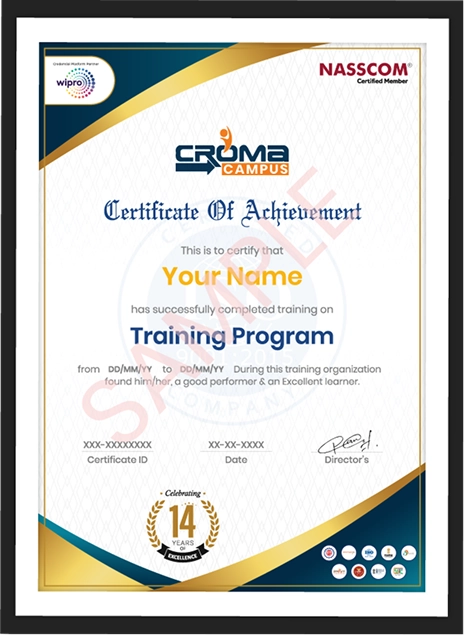- 3 Live Project
- Self-Paced/ Classroom
- Certification Pass Guaranteed
Course Offered By
Learn predictive analytics in SAS, Learn SAS GUI, datasets, data manipulation techniques, and import/export keywords in SAS.
You will also get an idea of iterative looping and conditional looping in SAS.
You will learn how to solve complex SAS problem using SAS.
You would know how to manage SAS programming using arrays.
Perform basic and advanced analytics using statistical techniques in SAS.
Know about automation or complex tasks that can be automated with the help of MACROs.
You would learn about invoking SQL queries using SAS.
The SAS placement course will help you to prepare for the certification and start applying for jobs in leading industries.
You must have a sound idea of SAS basics programming and SAS advance programming concepts.
You must know about the predictive analytics in SAS, SAS GUI, datasets, data manipulation techniques, and import/export keywords in SAS.
You must have an idea of iterative looping and conditional looping in SAS.
You should know how to solve complex SAS problem using SAS.
You must know how to manage SAS programming using arrays.
You should know about basic and advanced analytics using statistical techniques in SAS.
You must know about automation or complex tasks that can be automated with the help of MACROs.
You will also learn about invoking SQL queries using SAS.
we train you to get hired.
we train you to get hired.
By registering here, I agree to Croma Campus Terms & Conditions and Privacy Policy
Introduction
Understanding Concepts of Excel
Ms Excel Advance
SQL Server Fundamentals
SQL Server 2019 Database Design
SQL Tables in MS SQL Server
Data Validation and Constraints
Views and Row Data Security
Indexes and Query tuning
Stored Procedures and Benets
System functions and Usage
Triggers, cursors, memory limitations
Cursors and Memory Limitations
Transactions Management
Introduction to Power BI
Power BI Desktop
Power BI Data Transformation
Modelling with Power BI
Data Analysis Expressions (DAX)
Power BI Desktop Visualisations
Introduction to Power BI Dashboard and Data Insights
Direct Connectivity
Publishing and Sharing
Refreshing Datasets
Introduction To Python
Python Keyword and Identiers
Introduction To Variables
Python Data Type
Control Structure & Flow
Python Function, Modules and Packages
List
Tuple
Dictionary
Sets
Strings
Python Exception Handling
Python File Handling
Python Database Interaction
Reading an excel
Complete Understanding of OS Module of Python
Introduction to SPSS
Input and Data Cleaning
Data Import [Excel File]
Data Import [Text Data / CSV Data]
Scales
Data Manipulation
Visualisation in SPSS
Descriptive analysis of data
What is Significance
Statistical Tests
Correlation
Regression
Sampling
Tables
Multivariate Analysis [Factor Analysis]
Multivariate Analysis [Cluster Analysis]
Data Analysis with SPSS: General Aspects, Workflow, Critical Issues
SPSS: General Description, Functions, Menus, Commands
SPSS File Management
Defining Variables
Manual Input of Data
Automated Input of Data and File Import
Excel Data : Initial Preparation
Check Cell Range of Data
Give Variable Names
Store basic Checks Max Min Mean
Import into SPSS
In Notepad or Text Pad
Check Total No of Rows
How many Rows Per Case
How Many Variables
Import Text File
SAS Programming Essentials
SAS Programming - Data Manipulation Techniques
The SAS programming process.
Submitting a SAS program
Using SAS programming tools.
Understanding SAS syntax.
Diagnosing and correcting syntax errors
Mastering fundamental concepts
Understanding SAS data.
Accessing data through libraries.
Importing data into SAS.
Exploring data.
Filtering rows.
Formatting columns.
Sorting data and removing duplicates.
Reading and filtering data.
Computing new columns.
Conditional processing.
Enhancing reports with titles, footnotes, and labels.
Creating frequency reports.
Creating summary statistics reports.
Exporting data.
Exporting reports.
Using Structured Query Language in SAS.
Joining tables using SQL in SAS.
setting up for this course
understanding DATA step processing
directing DATA step output
creating an accumulating column
processing data in groups
understanding SAS functions and CALL routines
using numeric and date functions
using character functions
using special functions to convert column type
creating and using custom formats
creating custom formats from tables
concatenating tables
merging tables
identifying matching and nonmatching rows
using iterative DO loops
using conditional DO loops
restructuring data with the DATA step
restructuring data with the TRANSPOSE procedure
What is an Interview
Tips to clear an Interview
Common Interview questions and answers
SAS Interview Questions and Answers
Resume Building Guide
Career roadmap and certifications
Attempt for related Global Certification Exam
Start applying for Jobs
Use PROC SQL to perform SQL queries.
Select columns in a table with a SELECT statement and FROM clause.
Create a table from a query result set.
Create new calculated columns.
Assign an alias with the AS keyword.
Use case logic to select values for a column.
Retrieve rows that satisfy a condition with a WHERE clause.
Subset data by calculated columns with the CALCULATED keyword.
Join tables - inner joins, full joins (coalesce function), right joins, left joins, cross
joins.
Combine tables using set operators - union, outer join, except, intersect.
Sort data with an ORDER BY clause.
Assign labels and formats to columns.
Summarize data across and down columns using summary functions (AVG,
COUNT, MAX, MIN, SUM).
Group data using GROUP BY clause.
Filter grouped data using HAVING clause.
Eliminate duplicate values with the DISTINCT keyword
Subset data by using non-correlated subqueries.
Reference an in-line view with other views or tables (multiple tables).
Use SAS data set options with PROC SQL (KEEP=, DROP=, RENAME=,
OBS=).
Use PROC SQL invocation options (INOBS=, OUTOBS=. NOPRINT,
NUMBER)
Use PROC SQL with the SAS Macro Facility to create macro variables with the
INTO keyword.
Use SAS functions (SCAN, SUBSTR, LENGTH).
Access SAS system information by using DICTIONARY tables (members,
tables, columns)
Explain how SAS stores date and time values.
Use SAS informants to read common date and time expressions.
Use SAS date and time formats to specify how the values are displayed
Define and use macro variables.
Use macro variable name delimiter. (.)
Use INTO clause of the SELECT statement in SQL.
Use the SYMPUTX routine in a DATA Step.
Control variable scope with:
Define and use character arrays.
Define and use numeric arrays.
Create variables with arrays.
Reference arrays within a DO loop.
Specify the array dimension with the DIM function.
Define arrays as temporary arrays.
Load initial values for an array from a SAS data set.
Declare hash and hash iterator objects
Date and Time
Time Intelligence
Information
Logical
Mathematical
Statistical
Text and Aggregate
Overview :
R Programming Basics.
Variable types and data structures in base R.
Getting data into the R environment.
Data frame manipulation.
Handling dates in R.
Exploratory Data Analysis (Descriptive Statistics).
Working with text data.
Control flow & functions.
Graphics in R Overview.
Advanced R graphics.
Inferential Statistics.
General Linear Regression Models in R.
History of R
Advantages and disadvantages
Downloading and installing
How to find documentation
Using the R console and R Studio
Getting help
Learning about the environment
Writing and executing scripts
Object oriented programming
Introduction to vectorised calculations
Introduction to data frames
Installing and loading packages
Working directory
Saving your work
Variables and assignment
Data types
Numeric, character, Boolean, and factors
Data structures
Vectors, matrices, arrays, data frames, lists
Indexing, sub-setting
Assigning new values
Viewing data and summaries
Naming conventions
Objects
Built-in data
Reading data from structured text files
Reading data using ODBC
Save a workbook as a template,
copy macros between workbooks,
reference data in another workbook,
reference data by using structured references,
enable macros in a workbook,
display hidden ribbon tabs
Restrict editing,
protect a worksheet
configure formula calculation options
protect workbook structure
manage workbook versions
encrypt a workbook with a password
Create custom number formats
populate cells by using advanced Fill Series options
configure data validation
Create custom conditional formatting rules
create conditional formatting rules that use formulas
manage conditional formatting rules
Create custom color formats,
create and modify cell styles,
create and modify custom themes,
create and modify simple macros
insert and configure form controls
Display data in multiple international formats
apply international currency formats,
manage multiple options for Body and Heading fonts
Perform logical operations by using AND, OR, and NOT functions;
perform logical operations by using nested functions
perform statistical operations by using SUMIFS, AVERAGEIFS, COUNTIFS
functions
Look up data by using the VLOOKUP function,
look up data by using the HLOOKUP function,
look up data by using the MATCH function,
look up data by using the INDEX function
Reference the date and time by using the NOW and TODAY functions,
serialize numbers by using date and time functions
Reference the date and time by using the NOW and TODAY functions
import, transform, combine, display, and connect to data
consolidate data
perform what-if analysis by using Goal Seek and Scenario Manager
use cube functions to get data out of the Excel data model
calculate data by using financial functions
Trace precedence and dependence
monitor cells and formulas by using the Watch Window
validate formulas by using error checking rules,
Evaluate formulas
Name cells,
name data ranges,
name tables,
manage named ranges and objects
Add trendlines to charts,
create dual-axis charts,
save a chart as a template
Create PivotTables,
modify field selections and options,
create slicers,
group PivotTable data,
reference data in a PivotTable by using the GETPIVOTDATA function,
add calculated fields,
format data
Create PivotCharts,
manipulate options in existing PivotCharts,
apply styles to PivotCharts,
drill down into PivotChart details
VBA Basics.
Control Structures: Logical Expressions.
Control Structures: Loops.
Sub-Procedure and Functions.
Debugging.
Handling Text files, Pictures and charts.
VBA forms.
Database Connectivity:
Overview
The History of VBA
Why VBA
VBA Summary
Active sheet, Active cell, offset, sheet add, rename, etc.
Static & Dynamic
Array functions
Filter, cut, copy, paste, remove duplication, etc.
File system basics
Understanding file permissions
Setting file permissions
Accessing files
Writing to files
Deleting files
Reading files
Examining file details
Working with directories
Viewing directory content
If statements
Else and elseif statements
Logical operators
And. OR, Not. Go to Statements
Switch statements
While loops
For loops
For each loops
do while
do until
Continue
Break
Understanding array pointers
Subroutine
Passing value to sub- procedure
Message box
VBA Inbuilt functions
Passing values in functions
Workbook and worksheet functions
Keywords
Difference between sub-routines and functions
Creating own functions in VBA for Excel
we train you to get hired.
Phone (For Voice Call):
+91-971 152 6942WhatsApp (For Call & Chat):
+91-971 152 6942Stories
success
inspiration
career upgrade
career upgrade
career upgrade
career upgrade
You will get certificate after
completion of program
You will get certificate after
completion of program
You will get certificate after
completion of program
in Collaboration with

Empowering Learning Through Real Experiences and Innovation
we train you to get hired.
Phone (For Voice Call):
+91-971 152 6942WhatsApp (For Call & Chat):
+91-971 152 6942Get a peek through the entire curriculum designed that ensures Placement Guidance
Course Design By
Course Offered By
Ready to streamline Your Process? Submit Your batch request today!
SAS Training in Gurgaon is offered by Croma Campus. We’re a leading SAS Training Institute in Gurgaon. We provide the most learning environment for the major technical course at an affordable price. The best SAS Training in Gurgaon offered by the best technical IT training. We provide basic and advanced level SAS Training in Gurgaon with proper practical knowledge.
Our sturdy associations with prime organizations like HCL, Wipro, Dell, Birlasoft, TechMahindra, TCS, IBM, etc. make the U.S.A. capable to put our students in prime MNCs across the world.
Croma Campus in Gurgaon mentored more than 4000+ competitors with SAS Training in Gurgaon at a truly sensible charge. The course educational program is redone according to the prerequisite of applicants/corporates.
SAS Training Institute in Gurgaon included some important courses like SAS Programming, SAS Macro Language, SAS SQL, SAS Advanced Programming etc.
For details information & FREE demo class call us on +91-9711526942 or write to us info@cromacampus.com
Address: - G-21, Sector-03, Noida (201301)
Highest Salary Offered
Average Salary Hike
Placed in MNC’s
Year’s in Training

fast-tracked into managerial careers.
Get inspired by their progress in the
Career Growth Report.
FOR QUERIES, FEEDBACK OR ASSISTANCE
Best of support with us
For Voice Call
+91-971 152 6942For Whatsapp Call & Chat
+91-9711526942





















